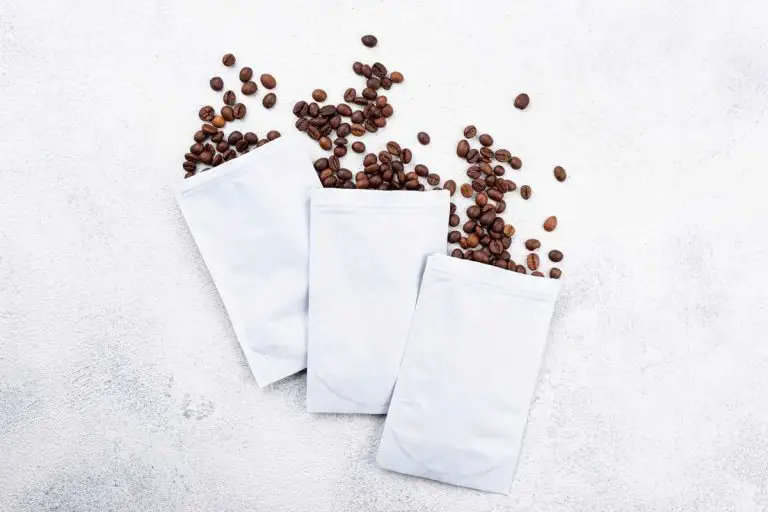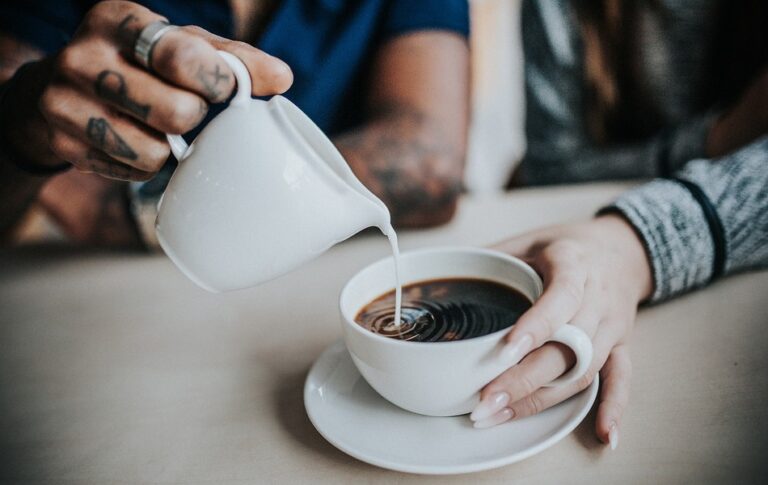The Complete Guide to Kopi Luwak Coffee in 2024
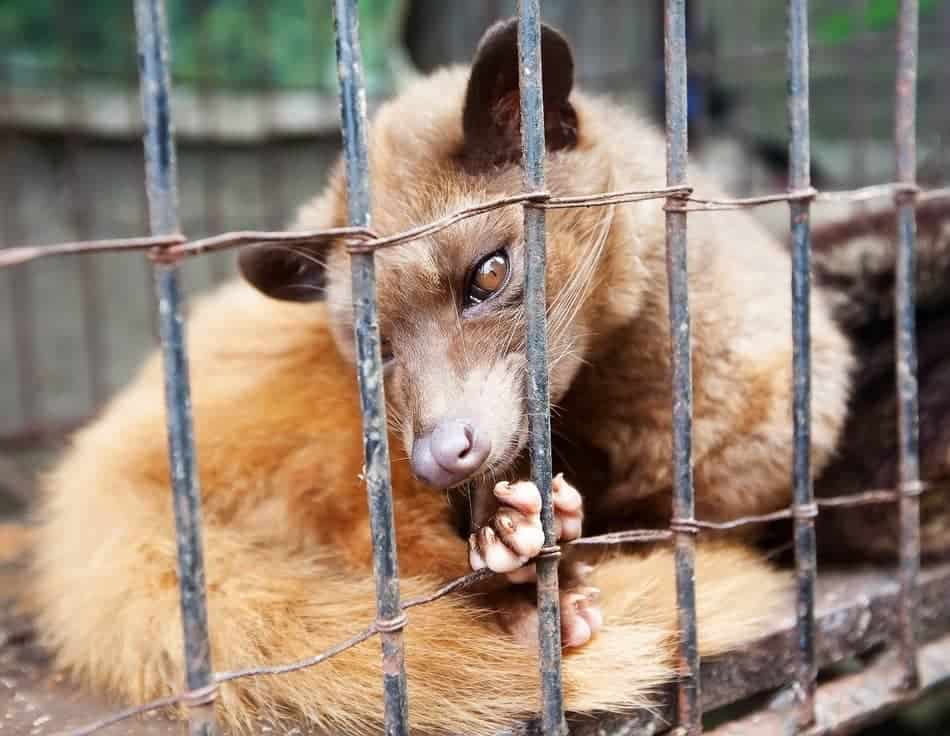
Kopi luwak, also known as civet coffee or cat-poop coffee, has been made famous by its appearance in the media as well as in Hollywood movies. But what exactly is kopi luwak coffee?
Kopi luwak is a coffee drink made from coffee beans that have been eaten and excreted by the Asian palm civet. The enzymatic process from inside the civet’s digestive tract is said to improve the coffee’s flavour. It is mainly produced in Indonesia, the Philippines, and Vietnam.
So why on earth would people part with good money for a cup of coffee that has come out of an animal’s backside?
How kopi luwak is produced and processed
Coffee made from beans that have passed through the Asian palm civet (Paradoxurus hermaphroditus) is referred to as kopi luwak coffee.
Kopi luwak is not a specific variety of coffee bean. Instead, the name comes from the process the coffee beans undergo whilst inside the Asian palm civet. Kopi is the Indonesian word for coffee, and luwak is the local Sumatran name for the Asian palm civet.
Wild civets consume coffee cherries as part of their natural diet. The coffee cherry, so-called due to its resemblance to normal cherries, is the fruit that houses what we know as coffee beans.
Civets are very selective when it comes to which coffee cherries they choose to eat. They always look for the ripest and most delicious cherries, something which is essential for great-tasting coffee.
As the coffee beans inside the coffee cherries are unable to be digested by the civets, they pass through the digestive tract whole, being defecated in clumps.
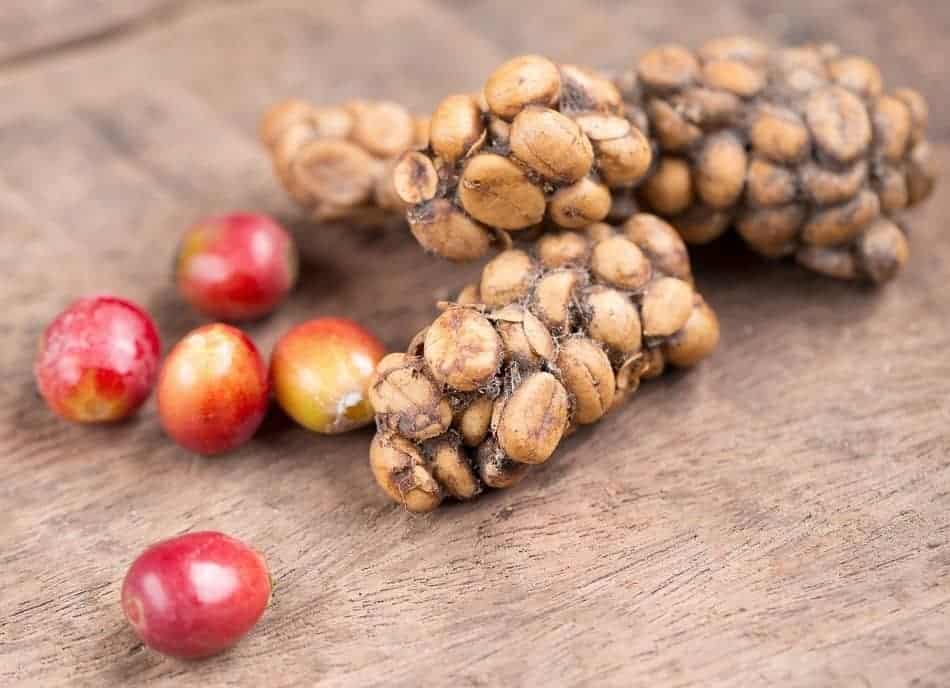
The civet’s stomach acid and enzymes digest the outer coffee cherry fruit covering and ferment the beans before excretion. This fermentation process is what gives kopi luwak its unique flavour.
The enzymatic process that the beans undergo inside the civet’s gastrointestinal tract breaks down and alters the protein structure of the beans. As proteins are partly responsible for the bitterness in coffee, the decreased protein level means that the drink is less bitter.
The increase in popularity of kopi luwak because of its uniqueness has led to the majority of it being mass-produced on farms to keep up with demand.
However, Asian palm civets are often kept in appalling conditions. They’re kept in tiny cages, being force-fed nothing but coffee cherries to maximize profits.
Around a day and a half after consuming the coffee cherries, the beans are defecated. The faeces containing the coffee beans are collected and processed by workers on the farms.
Through meticulous sorting, cleaning, washing, and drying, the beans are prepared for roasting, which can then be sold to consumers to make into a cup of coffee.
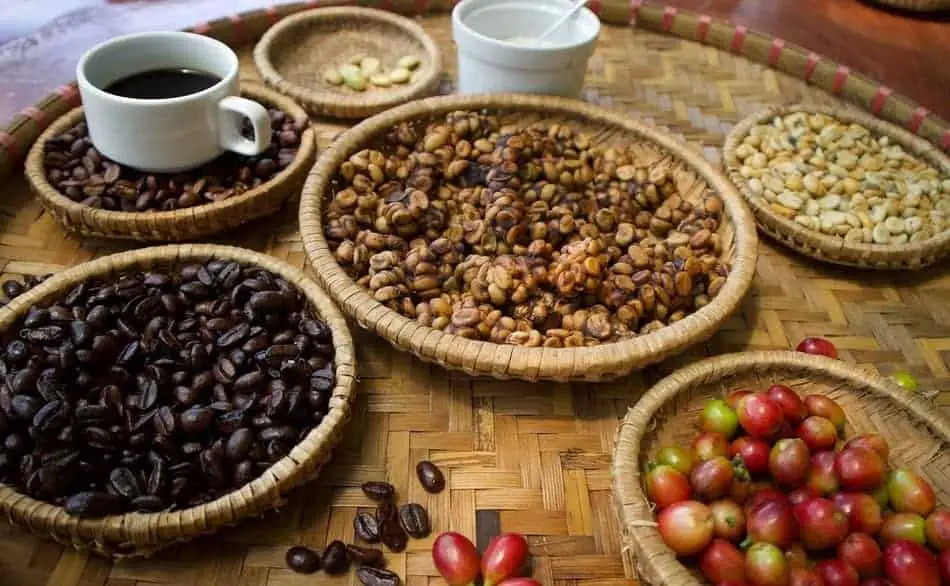
It is believed by some that the process of passing through the intestines of the civet gives the drink a smoother and richer taste, which is thought to justify the staggeringly high price of this coffee.
Despite its alternative name of cat-poop coffee, the Asian palm civet is not a type of cat of the felidae family. Palm civets are small, slender-bodied, mostly nocturnal mammals of the viverridae family, which are native to Asia.[1]
Where is kopi luwak produced?
Kopi luwak is mostly produced on the islands of Indonesia, the Philippines, and Vietnam. The annual production of genuine kopi luwak is around 500 – 700kg (1100 – 1500lbs) per year.[2]
The Indonesian islands that produce kopi luwak are Bali, East Timor, Java, Sulawesi, and Sumatra. The island of Sumatra is the world’s largest producer of kopi luwak.
In the Philippines, the coffee goes by different names depending on the region. It’s known as kape motit in Cordillera, kapé alamíd in Tagalog-speaking areas, kapé melô or kapé musang in Mindanao, and kahawa kubing in the Sulu Archipelago.
In Vietnam, kopi luwak is known as cà phê chồn, which translates into English as weasel coffee. Vietnam produces the least quantity of kopi luwak of these three countries.

What does kopi luwak taste like?
Advocates of the drink claim that it has a unique taste owing to the process that it undergoes whilst inside the civet. The drink is said to be a coffee that contains less bitterness and less acidity, contributing to a smoother flavour with a complex aroma.
It is worth noting that the taste of kopi luwak depends on a lot of factors such as the quality, origin, and the type of beans that are ingested by the civets.
The process that follows the collection of coffee beans by farmers, such as roasting and brewing, also has a big effect on how the coffee will taste.
The taste will also vary according to the health, diet, and overall condition of the civets themselves. For example, if the animals are constantly stressed, the beans that pass through the digestive system will have a very different taste to those with low stress levels.
Various assessments on the taste of kopi luwak have been made in recent years, and the results are rather shocking. The Specialty Coffee Association of America (SCAA) drew the conclusion that kopi luwak simply tastes bad.
Using the SCAA cupping scale, kopi luwak had the lowest score of all the coffees being cupped (tried and tested). Still, it was admitted that the reduced acidity and smoother body found in kopi luwak are characteristics that may appeal to some coffee drinkers.[3]
Another coffee professional compared kopi luwak coffee beans with ordinary beans and his findings were very similar. He stated that there was nothing that would make kopi luwak superior in comparison to other types of coffee.
Other food critics agree that kopi luwak is not good coffee. In addition, when a blind cupping taste test was held by professional coffee tasters, they also were not able to find anything extraordinary about the taste of this coffee.
Though they found the taste of kopi luwak to be noticeably different, noting that it was thin and less acidic, there was nothing that would make them prefer this type of coffee.
It can be concluded that people do not purchase kopi luwak because of its exceptional taste. In contrast, they buy it because it is so rare and unusual. Most people would agree that paying such a high price for this coffee is simply not worth it.
How much does kopi luwak cost and why is it so expensive?
A one-pound bag (454 grams) of wild kopi luwak coffee can cost as much as $600 ($1300 per kilo). Kopi luwak is one of the most expensive coffees in the world.[4]
In large Indonesian supermarkets, the price of farmed kopi luwak, which is considered to be of low quality, starts at $100 per kilogram (2.2lbs). In comparison, the price of local arabica coffee of high quality is about five times lower.
Kopi luwak can also be found in specialty coffee shops outside of Asia. There, a single cup of brewed kopi luwak can cost anywhere between $35 – $100.[4]
However, in Bali, a region that produces kopi luwak and a popular destination to try it, the price of a single cup is $4.[5]
The reason why kopi luwak is so expensive is that it is very unusual and in high demand. Due to the fact that it has to be processed in a very specific way, there is a very small supply.
Due to its rarity and the mystery surrounding it, there is a lot of demand for kopi luwak, which keeps the price high.
In addition, the production of kopi luwak is very labour intensive, no matter whether it is wild or farmed. Another issue is that the population of civets has decreased in recent years, meaning that production is even lower than before. All these factors contribute to the high price of kopi luwak.
The history of kopi luwak
The islands of Sumatra and Java are where this coffee first appeared at the beginning of the 18th century when Indonesia was under Dutch colonial rule.
The Dutch did not allow the native, Indonesian plantation workers to collect the coffee cherries for their own use.
It wasn’t long before they realised that the wild civets’ droppings contained undigested coffee beans. Not being allowed to drink the coffee that they were working so hard to produce, the natives decided to collect the coffee beans from the droppings.[6]
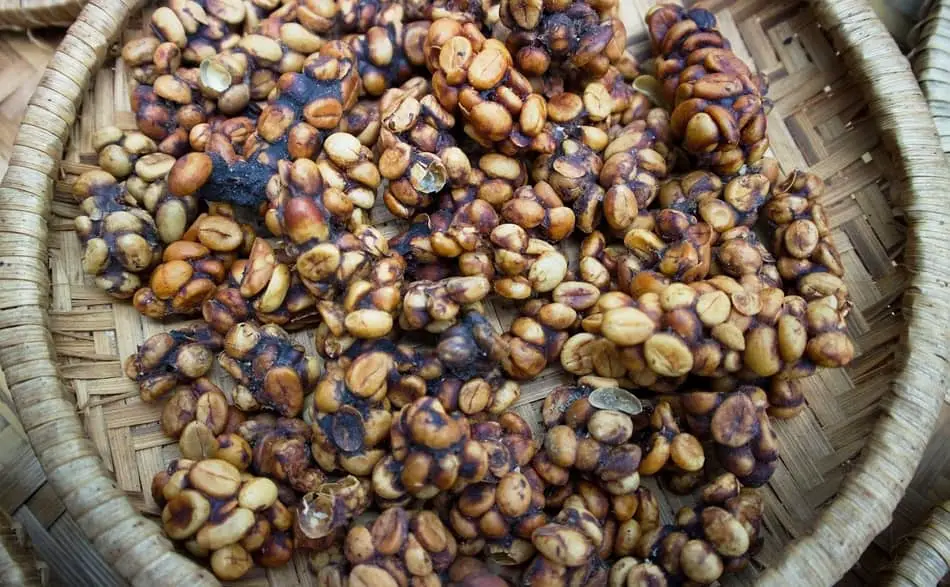
After cleaning, drying and roasting, they managed to brew their own coffee. They were amazed when they discovered that this drink was better than anything they had tasted before.
This new and original coffee beverage could not be kept a secret. When the Dutch plantation owners heard about it and tried it for themselves, they too preferred it to traditionally processed coffee.[6]
It quickly became a sought after product, which caused the price to rise dramatically. Its popularity grew and grew, and the coffee began being exported to Europe. The European demand for this novelty product further increased its price. But what was so special about it?
The reason that the coffee that had passed through the Asian palm civet was more delicious than the coffee that they were used to was down to poor production methods commonly found in the 18th and 19th centuries.[7]
Firstly, Asian palm civets are a lot more selective than coffee pickers when it comes to choosing coffee cherries. Coffee pickers were paid by weight and would pick under-ripe cherries to boost earnings; however, civets only picked the ripest cherries to eat. Just as with any fruit, a riper piece will always taste superior.
Secondly, beans that pass through the civet’s intestines do not have any fruit pulp remaining as the enzymes break them down during the digestion process.
When coffee beans are not sufficiently stripped of the fruit pulp and mucilage, it can lead to fermentation and mould forming, which impairs the flavour of the coffee. Fermentation and mould would have been commonly found back then as a result of poor processing techniques.[7]
So, the civet solved two issues found in coffee production back then, which of course resulted in a superior-tasting beverage that would have been a surprise to all who drank it.
Is kopi luwak safe to drink?
Even though the coffee beans come in close contact with pathogenic organisms associated with faeces, they do not contain significant amounts of these organisms and is therefore safe to drink.[8]
Most of the bacteria are on the endocarp that surrounds the bean, and the endocarp is removed when the farmer washes the beans.
In addition, when the beans are roasted, all the remaining bacteria are eliminated completely. Therefore, drinking kopi luwak is just as safe as drinking any other type of coffee.
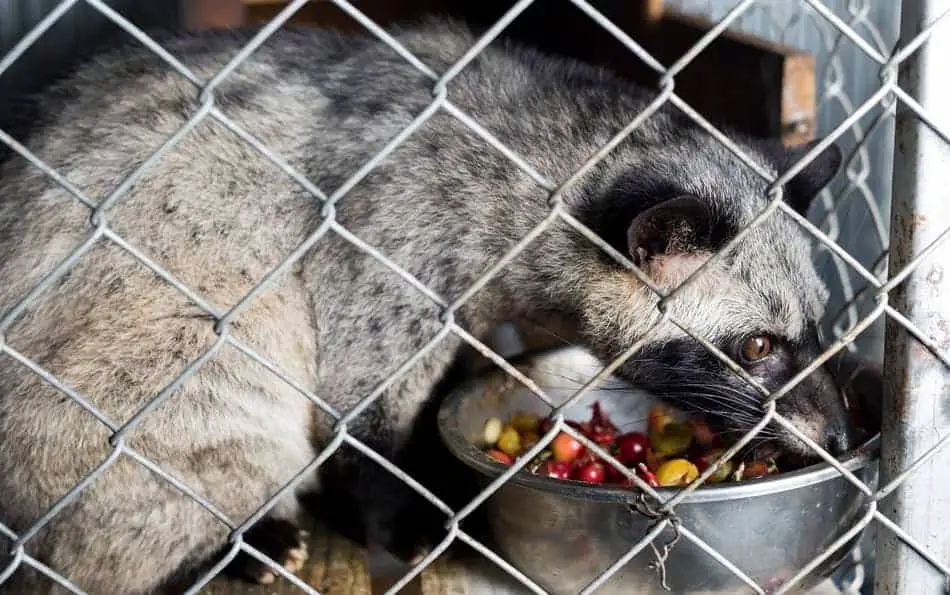
Is kopi luwak coffee cruel?
Kopi luwak production is very cruel. To maximize the production of kopi luwak, civets are kept in farms in terrible conditions. They are forced to live in tiny battery cages where there is no space for them to run around nor get any kind of exercise.[9]
The civets also end up fighting with each other, even though in the wild they tend to be very shy and friendly creatures.
As investigations show, these conditions lead to abnormal behaviours, causing the animals to pace, circle around, and bite the bars of their cages. Many civets lose their fur and, to make things even worse, many even die.
Being omnivores, the diet of wild civets is usually very rich and includes a vast variety of foods such as small mammals, insects, and different fruits.
However, the farmers of kopi luwak are only interested in force-feeding them nothing but coffee cherries. The result is poor health due to an unbalanced diet.[10]
This approach has certainly increased the production of kopi luwak but at what cost? Tens of thousands of Asian palm civets are suffering on these farms just to produce coffee that, as various assessments and professional tastings show, is not even good.
Why you should NEVER buy kopi luwak
The first reason is the animal cruelty that is involved in the process. Someone who spends money on kopi luwak coffee contributes to the industry that does not care about the ethical side of how this product is made.
The second reason is that the product that you will get if you buy kopi luwak will not be the one praised by the Dutch in the 18th century.
The original kopi luwak used coffee beans that passed through the digestive tract of civets that lived freely in the wild, and they are very different from those that live on farms in captivity.
The diet of wild civets, as well as their overall condition, is a lot better as they are completely free to roam and pick the coffee cherries to eat.
Due to the awful conditions in which civets live in captivity, the coffee that they end up making is different and worse than the original.
Thirdly, most of the kopi luwak that can be found on the market is fake. It has never been through or even near a civet. In fact, it is thought that as much as 80 percent of the global market of kopi luwak is fake.[11]
And don’t let the ‘wild-sourced’ label fool you either. As PETA and the BBC found, it often appears on coffee that comes from a farm with caged civets.[9]
It is very likely that you will end up paying a high price for a fake version of the rare coffee that you’re after.
Lastly, even if you manage to find authentic kopi luwak that is produced honestly and without animal cruelty, the price is simply not justifiable. Are you willing to spend over a thousand dollars on a kilogram of coffee?
Kopi luwak style coffee without animal involvement
A group of researchers from the University of Florida has found a way to imitate the civets’ digestive process to create a kopi luwak style coffee without torturing animals, and they have been issued with a patent for it.
The patented fermentation technology developed by Afineur, a start-up based in Brooklyn, is said to improve the taste and nutritional value of coffee beans, imitating the taste of kopi luwak.[12]
Moving closer to how kopi luwak was produced originally, there have been efforts made by various Vietnamese companies to make kopi luwak style coffee without the actual involvement of civets.
They produce their coffee with the use of an enzyme soak that, as they claim, has exactly the same effect on the coffee beans as the digestive process of civets.[13]
The reasons for this initiative of creating kopi luwak without animal involvement are straightforward. On the one hand, it stops cruelty towards civets while still providing all the fans of this type of coffee with their favourite beverage.
On the other hand, it also increases the production of an imitation kopi luwak as this new process does not require as much time or effort, which in turn lowers the price.
This leads to a kopi luwak style coffee becoming more affordable and more attractive for those who didn’t want to buy it because of how unethical it is.





